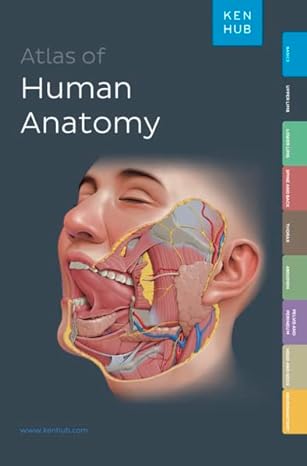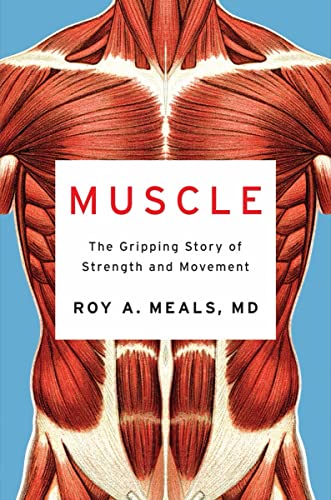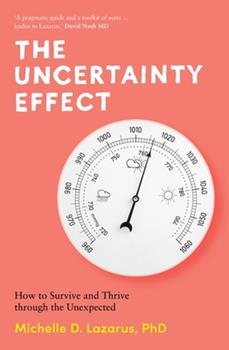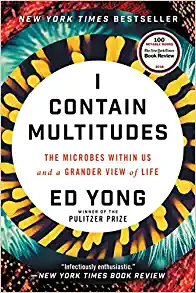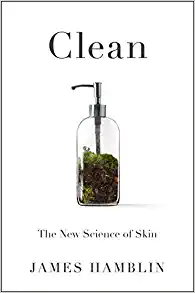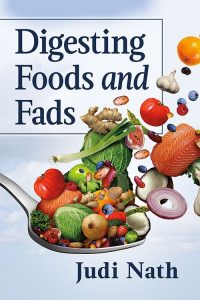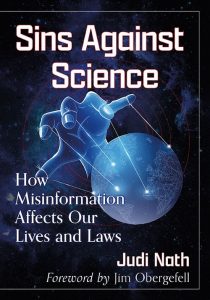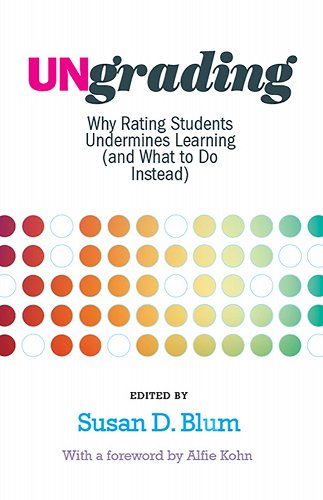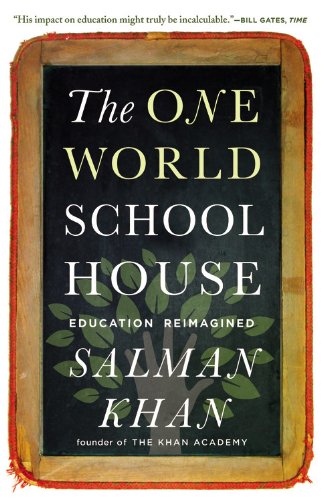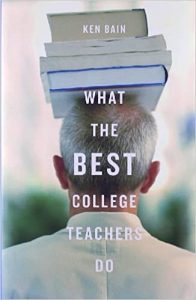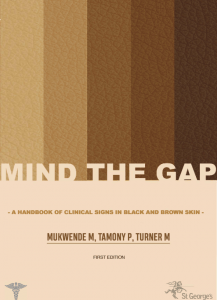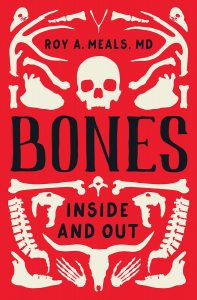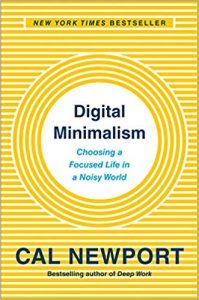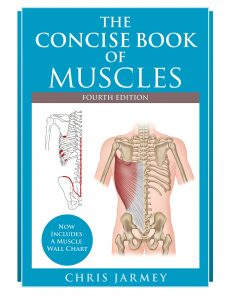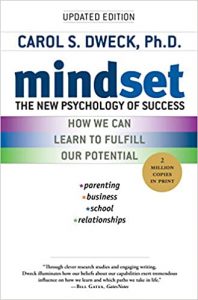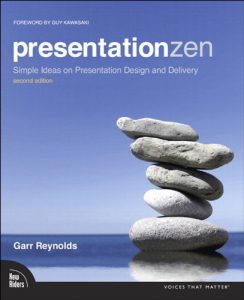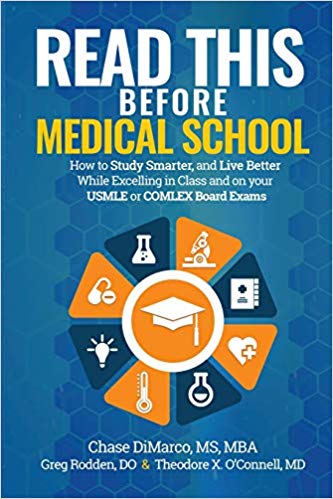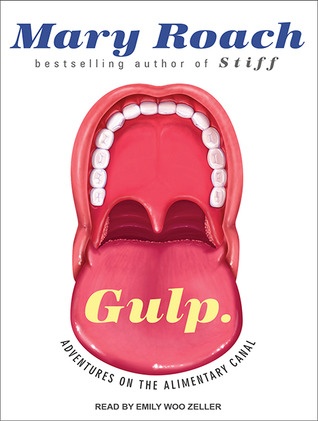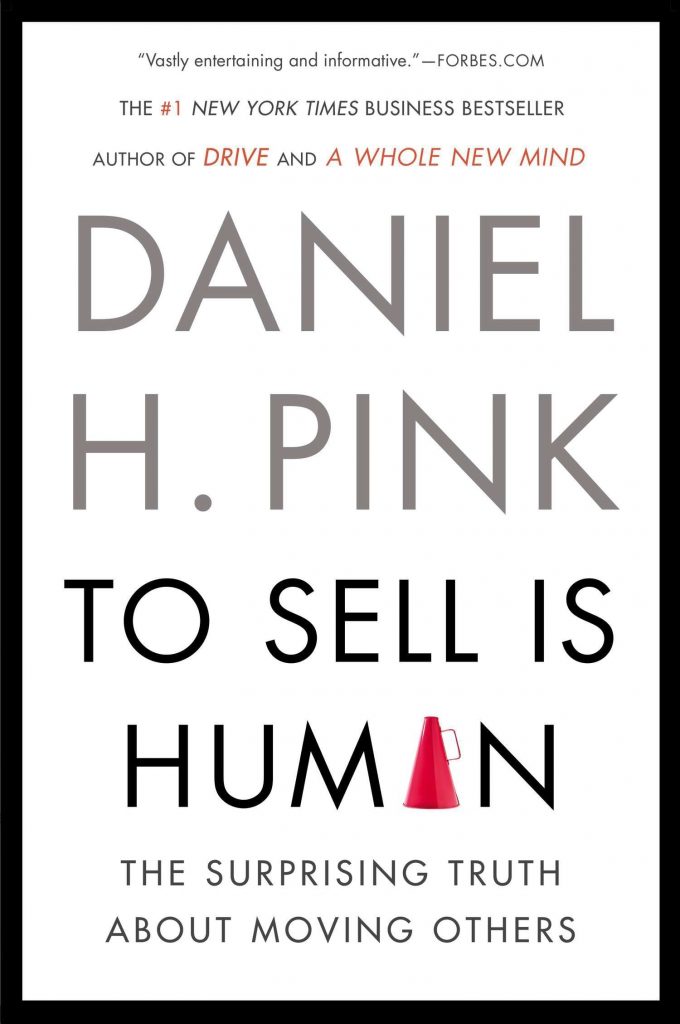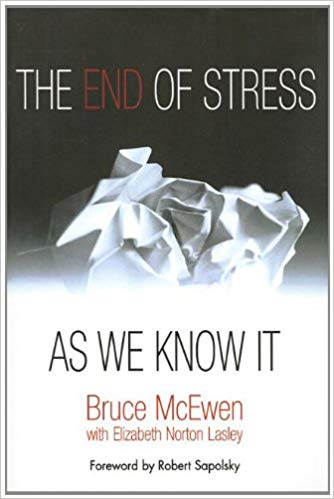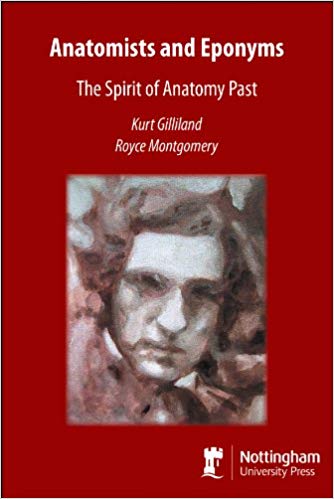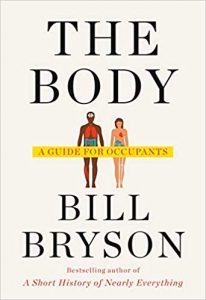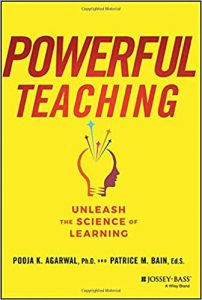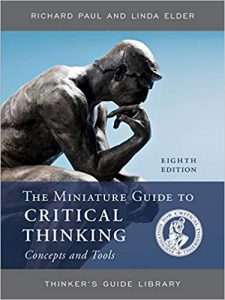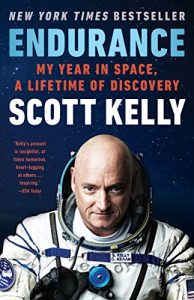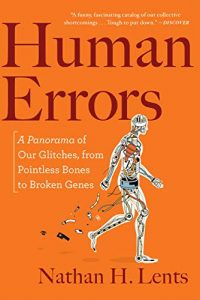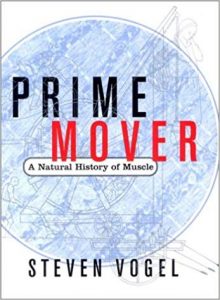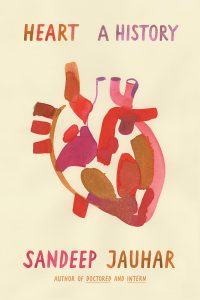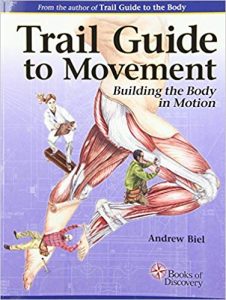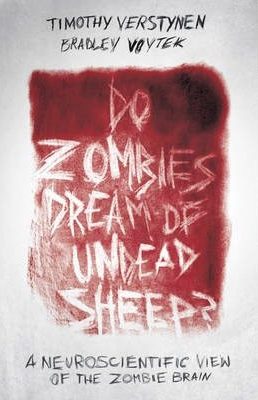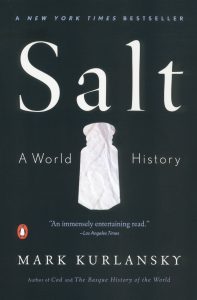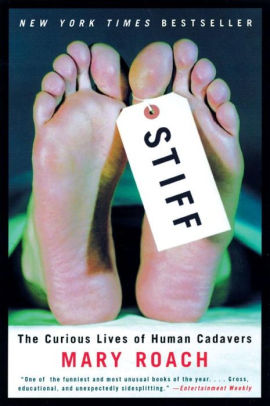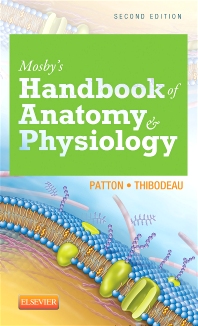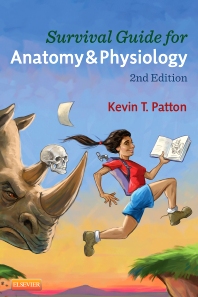The A&P Professor Book Club
Browse book reviews coordinated with The A&P Professor podcast and other resources. These books are of interest to most anatomy and physiology faculty. Some have obvious connections to A&P and others have connections that are a bit more obscure and intriguing.
Click on each book cover for more details from a bookseller site (we may receive compensation if you buy a book).
Kenhub Atlas of Human Anatomy
by Mike Pascoe
This pocket-sized atlas provides the best of both worlds by offering essential images and tables of human anatomy in print along with QR codes to take the reader directly to more resources related to the page topic. Thus, it’s a print manual with direct links to digital resources—win/win!
This first edition puts the best of Kenhub’s renowned resources into a print atlas that is designed with students in mind. Besides handy features such as a tab index on the front cover and numerous summary tables, this atlas also offers a distinctly more inclusive approach that we usually see.
Editor Mike Pascoe and the entire Kenhub team have done an excellent job of making learning anatomy more efficient for students.
From the publisher: This atlas represents a collection of clear, comprehensible and didactically valuable images from Kenhub, intuitively organized to aid you in your mastery of the organization of the human body. The features of this modern print atlas were formulated by direct input from students of anatomy and experienced educators. This print atlas was designed by the preferences of anatomy students to assist in the challenges of identifying structures in the anatomy laboratory and to assist in studying for written exams.
This book is discussed with Dr. Pascoe in Episode 144, which includes a link to a free 27-page sample.
Muscle: The Gripping Story of Strength and Movement
by Roy Meals
I read Dr. Meals’s previous book about bones and looked forward to reading his book about muscles. It does not disappoint! As an instructor of human anatomy & physiology, I love a book that brings me up to date on a central topic of our discipline at the same time it entertains, engages, and delights my curiosity about how the body works. It’s a fun book to read because the author loves to sneak in bits of humor and never fails to find the intriguing stories behind our current understanding of muscle. However, it also helps me expand and tweak the stories I tell in my own teaching.
From the publisher:
An entertaining illustrated deep dive into muscle, from the discovery of human anatomy to the latest science of strength training.
Muscle tissue powers every heartbeat, blink, jog, jump, and goosebump. It is the force behind the most critical bodily functions, including digestion and childbirth, as well as extreme feats of athleticism. We can mold our muscles with exercise and observe the results.
In this lively, lucid book, orthopedic surgeon Roy A. Meals takes us on a wide-ranging journey through anatomy, biology, history, and health to unlock the mysteries of our muscles. He breaks down the three different types of muscle―smooth, skeletal, and cardiac―and explores major advancements in medicine and fitness, including cutting-edge gene-editing research and the science behind popular muscle conditioning strategies. Along the way, he offers insight into the changing aesthetic and cultural conception of muscle, from Michelangelo’s David to present-day bodybuilders, and shares fascinating examples of strange muscular maladies and their treatment. Brimming with fun facts and infectious enthusiasm, Muscle sheds light on the astonishing, essential tissue that moves us through life.
This book is discussed in Episode 142
The Uncertainty Effect: How to Survive and Thrive Through the Unexpected
by Michelle Lazarus
At the time this writing, I’ve not yet read this book. It’s still in press and I pre-ordered it as soon as I read about it. However, after chatting with author Michelle Lazarus in Episode 135 of The A&P Professor podcast, I truly cannot wait to read it. I had so many light-bulb moments during our chat, I just have to know more! When your read it, let me know what you think, okay?
From the publisher:
In an age of pandemic and economic precarity, how can we learn to embrace uncertainty in our workplaces, schools and businesses? And how can better understanding uncertainty help us to build resilience, foster social inclusion and deal with the big issues, such as climate change? Award-winning educator Michelle Lazarus shows us how uncertainty tolerance can help. Drawing on years of her team’s own research, Michelle examines how teachers can help prepare students for an uncertain workforce, how healthcare administrators can help to reduce burnout in doctors, how scientists can better model the effects of climate change and how we can all contribute to equity in our workplaces. This lively book has an affirming message: we may not be able to predict the future, but we can learn to navigate it.
This book is discussed in Episode 135
I Contain Multitudes: The Microbes Within Us and a Grander View of Life
by Ed Yong
After hearing how much she liked this book, I asked my friend and colleague Terry Thompson to write a review/recommendation for our book club. Here it is…
Kevin asked me to write a book review of I Contain Multitudes by Ed Yong. When I recommended it for his podcast and book club. Now, this is not to be confused with the similarly named Bob Dylan song or the line in Walt Whitman’s Song of Myself poem. Although they all do share one common idea that everything really is interconnected.
The book’s subtitle, The Microbes Within Us and a Grander View of Life truly captures the grand scope and perspective of this book. The book isn’t all about humans, but that probably added to why I enjoyed it so much as someone with ethology, that is animal behavior background. We get to visit zoos and aquaria and field sites all over the world and deepen the oceans. We learn about pangolins and our pet dogs and bioluminescent squid and chemosynthetic giant tube worms. Although a 2016 publication date can seem a bit dated with the current pace of new research findings, it still seems so relevant in the current pandemic focus on microbes as enemies and public misunderstanding and mistrust of science. Yong’s writing helps put nuance and acceptance of change and uncertainty in science back into perspective. Yong shares contributions from many active clinical and research labs. While the book mentions the virome, the focus is on bacteria except for bacteriophages.
I’ve recently been reading about the microbiome at all levels…
…from popular writing to research and clinical references to help our author team fine-tune the integration of this emerging topic into the patent textbooks. Even with that background knowledge, I learned more details context for the topics of endosymbiosis, gnotobiosis, and horizontal gene transfers, HGT, and their role in the microbiome story. As a teaching resource on the topic, it’s well cited with 28 pages of notes and a 40-page bibliography.
However, the thing that most impressed me was the way Yong’s balanced voice and curiosity is able to effectively communicate not just the interesting information, but the history and whole process of science. Although the development of the microbiome extends through the whole book, the history chapter’s title of The People who Thought to Look captures his framing of Darwin’s Infusoria, Leeuwenhoek’s lenses, and the work of all the past to the current scientists.
Yong takes the process further to not only present the who, what, and where, but gets to the why, why not, and how questions of science and explains when and why answers to some of these questions are still not yet possible. Although you will not find the terms of correlation and causation in the chapter titles or index, dispersed throughout the book, Yong gives the best explanation and contextual presentation of these important science concepts for the general public that I’ve read so far.
To help readers understand the pace and role of the microbiome in the human, he uses analogies like biogeography and agriculture. He presents the conflict in deciding how to best address these microbes relative to humans, as it challenges the concept of an individual or self versus nonself. He also refutes the often presented 10-to-one ratio of microbes to human cells as instead being more equal, given the latest rough estimates of 30 to 40 trillion human cells and 39 trillion microbes.
He frequently reminds readers about the need to understand microbiome-related terms as neutral so they can avoid the two often inherent bias of a good versus bad dichotomy, when in fact both are possible in a given context. He also cautions about the need for healthy skepticism against the potential of overselling microbiome-related products and treatments.
I enjoyed Yong’s science writing so much, I’ve gone back to review his various articles in The Atlantic related to the pandemic and have also added his next book to my wishlist, An Immense World: How Animal Senses Reveal the Hidden Realms Around Us, due to be released in June of 2022. Maybe I’ll return with a review of that book if it relates enough to our teaching of senses in human A&P. Respectfully submitted, Terry Thompson.
This book is discussed in Episode 116
Clean: The New Science of Skin
by James Hamblin
I listened to the audiobook not long after it was released in 2020 and I loved it. So it’s now a Book Club recommendation!
Hamblin gives us a thorough and interesting historical and cultural discussion about skincare. I’m always interested in the stories behind why we do what we do and how things got to be the way they are today. That part of the book sucked me right in. In doing that, both he and I, the reader began to realize that the bathing and/or showering and lotions and skincare rituals that humans do have almost nothing to do with health and wellness.
That lack of a link between our modern skin care practices and health can lead to unhealthy conditions. It can mess up our skin’s microbiome.
And by doing that, it can mess up other things in our body, because we know it’s all connected, right? Everything in the body’s interconnected, even the human microbiome or human microbial system. One of the things in this book that is often one of the first things mentioned in the media is that while researching and writing this book, Dr. Hamblin decided to stop showering. Yeah, that’s true. He stopped showering and found out there’s a sort of let’s not shower movement that’s growing in popularity really.
Because it’s not really a spoiler I’ll tell you that when he says he stopped showering, it’s not really as drastic as it sounds. He still cleans himself regularly, just not in the harsh let’s utterly destroy our microbiome at least once a day kind of cleaning that has become the norm for a lot of people.
What exactly does he do? Well, that would be a spoiler. You’re just going to have to listen to or read the book like I did.
But his point is a good one. We need to learn to manage the microbial systems that exist in the different parts of our skin if we want to be healthy and well, we need to change those skincare rituals that we do and we do them just because they become a cultural norm for us. But to do that effectively, we need to understand way more about how our skin’s microbiome works.
The science is advancing rapidly and we need to stay tuned into that. This book is a way to get started. It goes into some of the core ideas about the skin’s microbiome in a clear and understandable way, enough to get us prepped, to keep learning more as the science advances. As I encouraged all of us to do back in Episode 47, I think we need to weave a very basic understanding of the human microbial system, the human microbiome, into the story of the human body that we tell our students in our A&P course.
Not only does that help our students understand current concepts of human biology and help them understand their own health, but it also helps prepare them for the emerging microbiom-informed therapies—or alterations of common therapies— that they’ll be working with in their careers.
This book is discussed (along with a discussion of the skin’s microbome) in Episode 114
Digesting Foods and Fads
by Judi Nath
I’d already started reading Judi Nath’s other general-audience book, Sins Against Sience: How Misinformation Affects Our Lives and Laws, when I received my copy of Digesting Foods and Fads. Thus, I wasn’t too surprised to see Judi’s considerable teaching and writing skills put to good use in explaining the stories behind that oh-so-important topic of food.
We all eat food, digest and absorb its nutrients, and do a lot of metabolizing. It affects our entire structure and function! So Judi set about to explain all that to ordinary folks. Reading this book, I feel like I’m in a class taught by Judi, but a class that allows her time to really get into some of those subtopics that we never seem to have time for when we’re teaching our A&P class.
As with Sins Against Science, this book would also make an excellent supplement or extra assignment for an A&P course or other science course. Especially if you need to cut your class time short when it comes to nutrition-related topics. Your students will thank you! Instructors considering this book for use in a course may request an examination copy here.
Here’s what the publisher says about this book:
It is time to tease sense out of the nonsense when it comes to eating smartly. This book offers advice on how to eat nutritiously every day without all the guilt, money, and discomfort wasted on the latest, greatest fad. Using the best scientific nutrition research available, this book will show how to navigate the complicated world of food with ease.
Peppered with historical background and fascinating facts, this is an introduction to basic nutritional practices. The book covers what foods you need, how your body uses the nutrients found in those foods, disease, sustainability, weight control, and food as medicine. It exposes the lies about supplements, fad foods, fad diets, and quick fixes. Armed with the knowledge that you are making the best decisions for yourself, there will be no need to chase after the latest magic potion or remedy.
If you want an interesting read—plus some info that may help your science teaching—check out this book. An interview with author Judi Nath is found in Episode 111
Sins Against Science: How Misinformation Affects Our Lives and Laws
by Judi Nath
When I first learned that my friend Judi Nath had written a “trade book” about science misinformation, I knew I had to read it! I’d already been following her blog posts dispelling misinformation and laying out principles for rationally interpreting science “in the news.” So I knew what to expect. And I was kinda right on that. Except that the book is even better than I expected.
You’ll learn more about what I like in the book by listening to the podcast episode where Judi and I chat about the book. One of those is that besides being an interesting and easy read, it’s chock full of stuff (which I learned from Judi is a technical biological term, ahem), that I can use in my teaching of A&P. Don’t we all want to be in command of contemporary science topics—especially controversial topics—when they inevitably come up in our class discussions? Here’s a excellent primer for that!
This book would also make an excellent supplement or extra assignment for an A&P course or other science course. Instructors considering this book for use in a course may request an examination copy here.
Here’s what the publisher says about this book:
Misinformation has had dramatic and dangerous effects, as evidenced by numerous events of the late 2010s and early 2020s. Reading a steady stream of misinformation leads to distrust, potentially leading to conflict in one’s family and workplace, and even to civil unrest. At the heart of many such matters is scientific illiteracy. Many people enjoy a life of ease and convenience because of science—and since science also crosses courtrooms, classrooms and cultures, it has great potential to debunk misinformation and untangle the confusion on such issues as vaccines, sexual identity, race and evolution, alternative medicine, and human reproduction.
This book addresses those issues and the popular stories, conspiracies, and misleading headlines that circulate across media platforms. Bringing accurate knowledge into people’s agendas is challenging, and this book uses science and facts as a basis of every deliberation over laws and policies. The chapters weave together history, politics, human biology, and law, and demonstrate how our lives are dependent on understanding the nature of things.
If you want an interesting read—plus some info that may help your science teaching—check out this book. An interview with author Judi Nat is found in in Episode 110
Ungrading: Why Rating Students Undermines Learning (and What to Do Instead)
by Susan D. Blum
Ungrading—really?! When I first heard that term in higher ed, I was puzzled. What could that mean? Why are more and more professors becoming enthused about it? Will the universe continue to exist without, um, grading? After looking around to see what the buzz was all about, I ran across this book.
It’s the first, I believe, to really lay out what ungrading is (or could be). Perhaps more importantly, this book give a lot of practical examples of how ungrading can be applied in a variety of ways. That’s often a sticking point for me—yeah, I get your newfangled philosophy, but how would it work in my course?
From the editors:
The moment is right for critical reflection on what has been assumed to be a core part of schooling. In Ungrading, fifteen educators write about their diverse experiences going gradeless. Some contributors are new to the practice and some have been engaging in it for decades. Some are in humanities and social sciences, some in STEM fields. Some are in higher education, but some are the K–12 pioneers who led the way. Based on rigorous and replicated research, this is the first book to show why and how faculty who wish to focus on learning, rather than sorting or judging, might proceed. It includes honest reflection on what makes ungrading challenging, and testimonials about what makes it transformative.
If you want a solid start in understanding ungrading, check out this book. I mean literally: check it out of your library and read it! Kevin’s expanded audio review is found in Episode 106
The One World Schoolhouse: Education Reimagined
by Salman Khan
I’ll never forget one of the first book clubs I ever participated in. It was something new at my college and was meant for faculty to discuss important and sometimes controversial books that might help us grow as educators. The first assigned book was by Salman Khan, you know, the guy that started Khan Academy, and is titled The One World School House: Education Reimagined.
This book drew me right in. It’s such a forward-thinking book that really resonated with some things I’d already been experimenting with in my own courses and found to be effective. Things I’ve already talked to you about and things I’ll be soon talking to you about. And it challenged me with ideas that didn’t resonate so well with me. Because they were either new to me or because they were in such opposition to what I thought I knew about teaching and learning that I was having a hard time getting past that threat to my own idea of the world. But as I mulled them over, I started to see where he was coming from and started to become more and more willing to see his perspective…
I found this book to be something that really got me thinking about how we do education, how students learn, and how I should be teaching or coaching students, how I should be active in assembling the infrastructure in my course, in my college, and in my course, to enable students to learn for themselves.
I felt encouraged to explore things outside the ordinary and think about how I could make my courses work in ways that facilitated learning rather than simply follow a recipe for making a suitable course.
From the editors:
A free, world-class education for anyone, anywhere: this is the goal of the Khan Academy, a passion project that grew from an ex-engineer and hedge funder’s online tutoring sessions with his niece, who was struggling with algebra, into a worldwide phenomenon. Today millions of students, parents, and teachers use the Khan Academy’s free videos and software, which have expanded to encompass nearly every conceivable subject; and Academy techniques are being employed with exciting results in a growing number of classrooms around the globe.
Like many innovators, Khan rethinks existing assumptions and imagines what education could be if freed from them. And his core idea-liberating teachers from lecturing and state-mandated calendars and opening up class time for truly human interaction-has become his life’s passion. Schools seek his advice about connecting to students in a digital age, and people of all ages and backgrounds flock to the site to utilize this fresh approach to learning.
In The One World Schoolhouse, Khan presents his radical vision for the future of education, as well as his own remarkable story, for the first time. In these pages, you will discover, among other things:
How both students and teachers are being bound by a broken top-down model invented in Prussia two centuries ago
Why technology will make classrooms more human and teachers more important
How and why we can afford to pay educators the same as other professionals
How we can bring creativity and true human interactivity back to learning
If you want your mind expanded a bit—challenged a bit—I suggest this book. Kevin’s expanded audio review is found in Episode 103
What the Best College Teachers Do
by Ken Bain
This book has been one of the most influential books about teaching that I’ve ever read. Even though I first read it about a decade and half ago, it is still with me—in so many ways.
Whenever I’ve tried my hand at something, whether it’s zoo husbandry, lion taming, tai chi, art, photography, or teaching, I always want to know who the top people are in that field. I want to know what makes them so good—what their secrets are. Not that I aspire to an icon, but because I want to use that knowledge to do my best. Well, that’s what the author Ken Bain did—checked out the most well-respected college teachers to see what secrets and tips he could find.
I think he expected to find some universal thread among all the top teachers. But he didn’t. However, he did find a lot of common themes and mindsets applied in a variety of different ways. I can’t go into all of them here, but I can tell you that they all resonated deeply with me. Some of them found me saying “oh yes, of course!” and others made me realize that I was already on a path leading me in that direction.
From the publisher:
Winner of the Virginia and Warren Stone Prize awarded annually by Harvard University Press for an outstanding book on education and society
What makes a great teacher great? Who are the professors students remember long after graduation? This book, the conclusion of a fifteen-year study of nearly one hundred college teachers in a wide variety of fields and universities, offers valuable answers for all educators.
The short answer is—it’s not what teachers do, it’s what they understand. Lesson plans and lecture notes matter less than the special way teachers comprehend the subject and value human learning. Whether historians or physicists, in El Paso or St. Paul, the best teachers know their subjects inside and out—but they also know how to engage and challenge students and to provoke impassioned responses. Most of all, they believe two things fervently: that teaching matters and that students can learn.
If you’re going to read a book about teaching, please read this one. Sure, it’s a few years old, but the lessons in it are timeless. Kevin’s audio version of this review is found in More Quizzing About Kevin’s Wacky Testing Scheme | Book Club | TAPP 100
Mind the Gap: a handbook of clinical signs on black and brown skin
by Malone Mukwende, Peter Tamony, Margot Turner
This free downloadable manual was created recently by a team that includes a teaching physician and a medical student. It is meant as a supplement to the gap that exists in medical and health professions training resources. It’s an admitted first try and it seems like this project will likely grow over time—they’re already adding new conditions and new photographs. So if you’ve been there before, you may want to check it again and look at the new content they’ve added. I think this project will also spark mainstream various reference and training manuals to help address this gap, too. And all of that together can help improve health outcomes and save lives.
A great thing for us as A&P teachers is that this gives a place to start with our students. A resource to use for teaching and learning. And setting the stage properly for our future health professionals.
This recommendation was made in Episode 87 of The A&P Professor podcast.
Bones: Inside and Out
by Roy A. Meals
After reading this book, I had the chance to meet and chat with author Roy A. Meals. And I’ve got to tell you, the enthusiasm for the topic of bones evident throughout this book is real and palpable in the man. As he often says, “it’s my passion.”
If you listen to my chat with him in Episode 82, you’ll discover that Meals also has a passion for teaching. In fact, after the interview was over, he told me that he never gets questions like I asked him, which were focused on what we as teachers can gain from reading his book. He said it was fun to discuss one of his “other” passions in life: teaching.
As I’ve often said, good teaching involves storytelling. Whether it’s in the form of a lecture, a group activity, or even a test, we are telling the story of the human body. The story of bone told in this book fits our storytelling well. Of course, it’s Meals’s version of the story, not ours. But by listening to Meals tell his story cannot avoid impacting our telling of the story. His excitement about and respect for bone will surely rub off on the reader and give a spark to our own story of bone.
Besides the awe and wonder of bone we’ll gain in our storytelling, reading this book will add many till tidbits of of information and lore about bone that will help us season and spice our lectures, demonstrations, and informal tutoring of students.
Even for those not teaching about bone, this book is a fascinating exploration of a substance that literally holds us up and keeps us moving. A substance that has an even more profound influence on our day-to-day lives that we imagine. Even giving a thumbs-up rating on this book, which I’m giving, requires bone tissue, right?
This recommendation was made in Episode 82 of The A&P Professor podcast.
Digital Minimalism
by Cal Newport
Lest you think that my advice to accept and even embrace the coming wave of digital textbooks and other digital tools is meant to keep you hooked on your electronic device, I’m happy to provide a counterbalance in the form of this contribution by our friend Mike Pascoe, who brings us another of his recommendations for The A&P Professor Book Club.
Hey, Kevin, Mike Pascoe here. I’ve got another recommended book for your book list. This one is not anatomy related, but I think it would benefit a lot of your listeners as they think about their own productivity and academia and really productivity in everyday life…
The book title is Digital Minimalism, and the author is Cal Newport. I think this will appeal to academics because the author Cal Newport is himself an academic. So he definitely speaks from a place of how to improve your productivity, what’s it like to do this high-level cognitive work. It really does resonate with the academic. Even though as he goes through his book on Digital Minimalism, it really is targeted at a general population.
So I really just love the way he structured the book, the topics he goes through, the research that he highlights. It’s really just changed the way I view the device that I’m recording this on right now, how often am I accessing my mobile device, how am I using it, how was it even intended to be used, and how can I break free and what am I losing and what can I gain by spending more of my time in analog pursuits.
So I really think it does inform not only my own productivity and my own outlook on how much time I’m spending on my mobile device, but it really does inform me on how my students might be using these devices and what the risks and benefits are around their own usage around these devices. Because we all know technology-enhanced learning is becoming a mainstay in anatomy education. So that’s my second title, my second recommendation for the A&P book list, and thanks for allowing us to submit our recommendations.
This recommendation was made in Episode 76 of The A&P Professor podcast.
The Concise Book of Muscles
by Chris Jarmey
What a great name for a book about muscles, right?. I like muscles and I like concise presentations of anatomy and physiology. So far, so good. It’s written by Chris Jarmey, who was a considered an outstanding teacher by his students and all-around nice guy. So yeah, definitely a book worth opening, opening.
When I first opened it, I was immediately drawn in by the outstanding art. Not just pretty—and it is. But really, really clear. When I’m looking of information about a particular muscle and I want to see where it is—and where EXACTLY the origin and insertion are—I want all that to be clear to me right away.
One of several things I love about this book is that it shows a great illustration of each muscle isolated enough that I can see the whole thing in its anatomical context. I can’t always do that in a typical A&P textbook or even any of those huge, awesome anatomical atlases. There just isn’t the space to really have all the muscles in large, clear illustrations. So yeah, I’ve got a lot of other references for muscles, but this one is great supplement to add to the information I already have on my bookshelf.
There are also supporting illustrations showing where the various origins and insertions are on the skeleton, relative to each other. And, get this: summary tables! I love, love, love summary tables like these. They make accessing detailed information about each muscle easy to find and easy to digest. Besides that, by putting information about muscles from one region side-by-side, I can see patterns and draw insights on my own. I can’t easily do any of that when all I have is paragraphs of narrative text.
And, as the name implies, it’s, well CONCISE. That is it just has that information that I’m typically looking for—leaving out details that usually get in the way when I’m raiding a book to find the core characteristics of a particular muscle.
I can see myself using this book not only for my own exploration and reference, but also as a teaching tool. I want a copy in my office and in the teaching lab, so that I can pull it out any time and show a student exactly what’s going on with that muscle they’re having trouble learning. Something a bit different than the jumble of muscles they might see in their textbook, lab manual, lab model, or dissection specimen.
I might need two copies so I have it handy wherever I need it, when I need it.
This recommendation was made in Episode 73 of The A&P Professor podcast.
Mindset: The New Psychology of Success
by Carol S. Dweck
After reading the study that Krista Rompolski and I discussed in Episode 71, I became curious about the concept of mindset and, in particular, how mindset affects learning and—by extension—how mindset affects teaching.
So I went back to the source: a book called Mindset: The New Psychology of Success. This book first came out in 2006 and became a huge bestseller. Where was I? I completely missed it. There wasn’t a book club for A&P faculty back then, that’s probably how I missed it!
It’s now available in an updated version…
and that’s what I’m recommending now.
After decades of research in motivation, renowned Stanford psychologist Carol S. Dweck, discovered a simple but groundbreaking idea: the power of mindset.
In her book, she shows how success in school, work, sports, the arts, and almost every area of human endeavor can be dramatically influenced by how we think about our talents and abilities. People with a fixed mindset—those who believe that abilities are fixed—are less likely to flourish than those with a growth mindset—those who believe that abilities can be developed. The Mindset book reveals how great teachers and other coaches and leaders can put this idea to use to foster outstanding accomplishment.
In the updated edition, Dweck offers new insights into her now famous and broadly embraced concept. She introduces a phenomenon she calls false growth mindset and guides people toward adopting a deeper, truer growth mindset. She also expands the mindset concept beyond the individual, applying it to the cultures of groups and organizations. With the right mindset, you can motivate those your students—to transform their lives and your own.
This recommendation was made in Episode 71 of The A&P Professor podcast.
Presentation Zen: Simple Ideas on Presentation Design and Delivery
by Garr Reynolds
The name of this book pretty much sums up the central message, and that is, simplifying our presentations, specifically our slide presentations, in a way that makes them way more effective.
This is a quest that I’ve been on for decades, one that I share more about in Episode 66. This book is a perfect companion to that discussion because it’s one of the many tools I’ve used to simplify and improve my presentations over the years.
There’s a lot of advice in the book, but three pieces of advice that really pop out for me are these:
Number one, tell a story. That is, tell it, don’t put it all on your slide. Don’t let your slide tell the story. You tell the story. Your slide is just a tool that you’re going to use for you to tell your story.
Tip number two that I learned from the book is use pictures a lot. That’s what helps students really get it, and particularly in our fields of anatomy and physiology.
The third thing that’s in the book that really resonated with me is keep each slide simple. Think about that. Do you really want them reading the slide or do you want them listening to your story? Hopefully, they’re listening to your story, not reading the slide, so you need to keep that slide as simple and as text-free, text-sparse as possible.
I’ll leave the rest for you to discover and mull over and decide what you want to incorporate into your own teaching.
This recommendation was made in the Preview to Episode 66 of The A&P Professor podcast.
Read This Before Medical School:
How to Study Smarter and Live Better While Excelling in Class and on your USMLE or COMLEX Board Exams
by Chase DiMarco, Theodore X O’Connell, Greg Rodden
Recognize that name, Chase DiMarco? He’s the guy I chat with in the full episode 64.
As you can tell from the title, this book is for students in medical school. And you may teach medical students, or students in some other health profession program. Or maybe you’re teaching A&P to pre-meds, or pre-nursing, or any of the many other students in a typical A&P course. This book could be helpful to any of them, really.
Why?…
Because all the students I just mentioned are being hit with what surely feels like a firehose of information. It feels that way, because it really IS a lot of information and ideas to learn in a very short period of time. And most of them will eventually be facing licensing or other professional exams of some sort, right? Whether its COMLEX or NCLEX or even tryouts for Jeopardy!, the advice and strategies offered in the book could be a game-changer for some students.
This book covers all the important things to consider when trying to figure how to succeed in A&P:
• Why study skills are important
• Why class participation is essential
• How to use the teacher’s time & resources effectively
• Using school resources
• How to study at home, including making a study plan and managing time effectively
• The value of study groups and how to organize and run a study group
• And even how to optimize work-life balance
There’s also a big section on test prep, with strategies for both course exams and those big professional exams I just mentioned a moment ago.
And because there’s lots of memorization required in A&P… Yeah, you KNOW there is, right?… There’s a big section on memory strategies.
This is a great book to have on your teaching bookshelf to offer to students as a place to start learning how to study and how to handle that firehose of ideas in A&P. Or perhaps add to your list of recommended resources.
This recommendation was made in the Preview to Episode 64 of The A&P Professor podcast.
Gulp: Adventures on the Alimentary Canal
by Mary Roach
This was an audio recommendation from listener Mike Pascoe…
The first is a book that is anatomically related, and that is Gulp, by Mary Roach. I believe the subtitle is, Adventures on the Alimentary Canal. So I really enjoyed this book. I really got hooked on Mary Roach after reading her book, I think most anatomists will know about, Stiff, about cadavers. And really with Adventures Along the Alimentary Canal it’s really interesting. There’s a lot of really cool topics that she unpacks by talking to scientists that do a lot of research on these really interesting questions. It’s really one of these types of books that is kind of put out there as the alimentary canal, the digestive system, digestive topics, as being a bit taboo. And things we don’t really, we’re not really encouraged to talk about.
But it’s a lot of fun to think about things that the book covers, like how much can you eat before your stomach bursts? Could a wine taster really tell the difference from a $10 bottle of wine to a $100 bottle? Can constipation kill you? Things like that. So it is written quite well, I really enjoyed going through it. A lot of really neat clinical correlates and pearls to include, and to add into some of my teaching. And I just recommend that folks take a look. It’s a pretty quick read, or a quick listen if you’re an audiobook subscriber.
Well, thanks Mike. Yeah, I’m a big fan of Mary Roach’s writing, too.
This recommendation was made in the Preview to Episode 63 of The A&P Professor podcast.
To Sell Is Human: The Surprising Truth About Moving Others
by Daniel H. Pink
According to the U.S. Bureau of Labor Statistics, one in nine Americans works in sales. But, according to the author of our new pick for The A&P Professor Book Club, so do the other eight. The book is called To Sell Is Human: The Surprising Truth About Moving Others and was written by Daniel Pink.
Why did I even read a book about selling, you might ask? Partly , it was …
because I’d learned a lot from another book by Daniel Pink, which I’ll save for a different day.
But mainly it was because of the subtitle of this book, that is, The Surprising Truth About Moving Others. I’d heard Pink talking about that aspect of the book and I was really interested in learning as much as I could about motivating my students. And this book did not disappoint. In fact, the idea of motivating students came up as example in the book of the many ways that we are sellers—in this case, sellers of ideas and of mastery of concepts. In other words, I know why putting a lot o effort into learning as much as possible about the human body while taking and A&P course will help a student be well prepared for later courses and for a career in the health professions—but I have to sell that idea to incoming students. If they buy into that, then keeping them motivated is not so hard. Sure, I may have to keep servicing that sale and reminding them of the benefits of hard work and mastery of concepts—but that’s all part of the selling I have to do as a teacher.
But as I read it, I realized that I’m not just selling mastery of anatomy & physiology to my students. I’m also selling the course, and any other course I develop, to my colleagues and administrators. Especially those on the curriculum committee. I sell ideas and my proposals to granting agencies. I sell my expertise and experience when I apply for, then present workshops and seminars. I’m doing the same thing in every episode of this podcast. I sell myself when I run for a seat on a committee or board or in a professional organization. When I submit a manuscript, or pitch a book or article idea, I’ve got to sell it. Yikes, my job is mostly about sales, it turns out.
To Sell Is Human offers a fresh look at the art and science of selling. Pink draws on a rich trove of social science for his counterintuitive insights. He reveals the new ABCs of moving others (it’s no longer “Always Be Closing”), explains why extraverts don’t make the best salespeople, and shows how giving people an “off-ramp” for their actions can matter more than actually changing their minds.
Along the way, Pink describes the six successors to the elevator pitch, the three rules for understanding another’s perspective, the five frames that can make your message clearer and more persuasive, and much more. The result is a perceptive and practical book–one that will change how you see the world and transform what you do at work, at school, and at home.
To Sell Is Human: The Surprising Truth About Moving Others by Daniel Pink is an enjoyable alternative to the kinds of books you’ve probably been reading lately. And I know you’ll gain a lot of insights about teaching and your other professional activities.
(Some of this commentary is based on an editorial summary of the book.)
This recommendation was made in the Preview to Episode 61 of The A&P Professor podcast.
The End of Stress as We Know It
by Bruce McEwen & Elizabeth Norton Lasley
I wonder if you’ve experienced any kind of stress over the last week. Most people would say yes to that, me included. After all, I have a podcast episode to get out and the preview to that, and select a book club recommendation for that preview. Okay, my heart rate is already higher than it was a few minutes ago just thinking about the stress I was feeling.
But really, what is stress? And what’s the best way to explain it as a physiological phenomenon to our A&P students? I did my graduate research in physiological stress and I often struggle with how to explain it to my students in a way that will both expand and deepen their understanding. After all, stress is part of our lives and it touches on nearly every aspect of what the future health care professionals taking my A&P course will be doing in their careers…
So it’s, um, well, kinda important, right?
In a book called THE END OF STRESS AS WE KNOW IT, the leading authority on stress, Bruce McEwen of Rockefeller University, tackles the whole stress story. Besides explaining the ins and outs of stress as a physiological phenomenon, he also updates our understanding of stress as allostatic load—a kind of coping with abnormal conditions or situations.
If you want an interesting read on an important topic that you already cover in your own story of the human body told in your own course, this is the book for you. I guarantee that your story will shift in many ways as you read McEwen’s version of a story that he’s been refining for an entire lifetime.
THE END OF STRESS AS WE KNOW IT is the current recommendation from The A&P Professor Book Club, and one of those essential books that every A&P teacher ought to have in their professional library. Or on their Kindle or iPad. Or wherever.
This recommendation was made in the Preview to Episode 60 of The A&P Professor podcast.
Anatomists and Eponyms: The Spirit of Anatomy Past
by Kurt Ogden Gilliland & Royce Montgomery
This little book is not very big. But when you start to skim through it, and I’m telling you, you are going to start skimming through it after you pick it up, you’ll be impressed with how much is inside this little book. It’s one of those books you pick up in a bookshop to glance inside and a half hour later you find yourself still standing in the same spot and checking your watch to see if you have more time to spend exploring through the book.
Anatomists and Eponyms: The Spirit of Anatomy Past starts out with a brief explanation of what eponyms are and their role in scientific and medical terminology. And then there’s a brief synopsis of the history of anatomy through the ages. But, the main part of the book looks at the anatomists who lent their name to body structures, organized by systems of the body. Although that initial history synopsis is brief, I think it’s important.
I always kick off my A&P course with a similar story, so I like hearing someone else’s take on it. Doing that makes my story better. I think it also helps students understand how we got to where we are, as well as the cultural factors that will continue to influence how we do human biology into the future.
But back to the main part of the book, the scientists behind the eponyms, all I can say is try to stop. I dare you. Each brief entry, which is also illustrated, is fascinating because it brings us face to face with the people behind the names. We now know what they look like, at least in some cases, who they were, and some interesting tidbits of information about their lives and their work. Because each entry is brief and also interesting, we just naturally want to move to the next one because, well, it only takes a couple of minutes to read the next one. It’s like french fries. Just one more won’t make any difference, right? Pretty soon, the whole supersize bowl of fries is gone.
This is both a fun read-through the first time and a useful tool to pull off the bookshelf from time to time as you’re teaching A&P.
This recommendation was made in the Preview to Episode 58 of The A&P Professor podcast.
The Body — A Guide For Occupants
by Bill Bryson
This recommendation comes from a listener. Marty Port. Before I get to Marty’s recommendation I just want to lead off with a comment of my own. I’ve not read this book yet, but it’s been on my Kindle since it was recently released. I’m a long time reader of Bill Bryson’s books. Many of which are travel related.
Some of you know that I have a long history of educational travel. Organizing and leading college and community study tours and safaris to around two dozen countries, on five continents. So, Bryson’s travel stories then, really stimulate my travel and adventure nerves. It turns out that Bill Bryson has a unique and entertaining voice when telling stories about his travels, which I’m guessing also apply to travels in the human body. So, I’m looking forward to a good read.
Marty Port sent me a couple of different messages about this book, which tells me that he’s really enthused about it. And I kind of, mashed them together for you here:
“Bryson is a very well known author of books for general audiences, whose written about a variety of topics including the Appalachian Trail, history, literature, among many others.”
“This book covers a large number of topics about the human body in health and disease, which are of interest to A&P Professors and students. It’s full of entertaining stories, which I have already been able to employ in my A&P one class.”
“Specifically some stories about anatomic variation and medical errors, which I was able to work into a recent class on the muscular system. For example, in the chapter called In The Dissecting Room, The Skeleton, Bryson brings up the issue of anatomic variation by stating that the palmaris longus is missing in about 14% of people.” Who knew?
He further explained that, “Since it is not all that important when present, it’s used by surgeons as a source for tendon grafting. I happened to be reading about the palmaris longus, about the time I’d listened to your podcast on anatomic variations.”
“To this point, I had never bothered to mention anatomic variations. So, in the middle of discussing the muscles of the anterior forearm I mentioned the palmaris longus and went into the issue of variations.”
“Since I was on a variations roll, I mentioned situs inversus, which was featured in your podcast, and the fact that it was rare. Occurring in about one in 10 thousand people.”
“And guess what? One of the students raised her hand and announced that her brother has situs inversus. What were the odds? Oh, right, one in 10 thousand. That 15 minute segment of lab class was a lot more interesting to the students, and to me, than any other 15 minute segment all semester.”
“Bryson’s book is chock full of facts just like this. I discovered your podcast and HAPS a couple of months ago, and caught up on all the podcasts. There’s a significant degree of synergy between your information and the entertaining stories in Bryson’s book.”
“It would be a good fit for the book club.” Well, thanks a lot, Marty. I really appreciate the time and effort you took to share this with us. Especially the specific ways in which it helped in your teaching. That’s super.
Now, I’m looking forward to reading this book even more. I’ll be a better storyteller for listening to Bryson’s storytelling about the human body.
Hey, let’s make this a regular book club, okay? First we need to get out a glass of wine or a cup of tea, and then find a comfy chair near a fireplace, and tell the rest of us what you think of this book. Or any book from the A&P Professor book club.
Just call or write in, and I’ll share your comments on this podcast. Well, depending on how much wine you’ve had before you make your call.
This recommendation was made in the Preview to Episode 58 of The A&P Professor podcast.
Powerful Teaching: Unleash the Science of Learning
by Pooja Agarwal and Patrice Bain
Both authors of this bookvare very well known education and learning experts.
This recommendation comes from listener Kim Terry. Kim said that she liked that it looks into how we learn and how we remember things and how we can help our students do it with quick and easy activities in our classes. As far as I’m concerned, quick and easy is always a good strategy, right? And this book, just flipping through it, I haven’t read it yet. I’ve had it for a little while. It came out not too long ago but I’ve had it for a little while, and I just haven’t gotten to it yet but I have flipped through it, so it’s on my list.
I follow Pooja Agarwal’s adventures on her website, which is called retrievalpractice.org. And I’ve learned a lot from that and I really gained a lot more appreciation than I already had going into it for retrieval practice and for different strategies that are related to retrieval practice or can be used along with retrieval practice. And according to the publisher, this book has several objectives. One is to develop a deep understanding of powerful teaching strategies based on the science of learning, so this is all evidence-based stuff. Another objective is to gain insight from real world examples of how evidence based strategies are being implemented in a variety of academic settings. Another objective is to think critically about your current teaching practices from a research based perspective and also to develop tools to share the science of learning with students and parents, ensuring success inside and outside the classroom.
The publishers claim that this book is an indispensable resource for educators who want to take their instruction to the next level. And if all they do is explain what were retrieval practice is, I think they could accomplish that goal. But of course, it goes way beyond that. So equipped with scientific knowledge and evidence-based tools, teachers can turn teaching into powerful teaching and unleash student learning in any kind of classroom.
One caveat that I ought to mention is that a lot of folks talking about this book mention that it has a lot of applications in K to 12 classrooms. And I’ve seen and heard some higher education colleagues dismiss the idea of implementing K-12 strategies in college courses. Oh, poor dears. Don’t they realize that these principles operate in humans in general and not just kids? Well, I’m telling you, they do. And some of the best teaching advice and experience I’ve gotten has been in K-12 classrooms. As I tell my youngest son, try not to have rock brain. You’ll miss out on a lot if you do.
This recommendation was made in the Preview to Episode 57 of The A&P Professor podcast.
The Miniature Guide to Critical Thinking Concepts and Tools (Thinker’s Guide Library) Eighth Edition
by Richard Paul and Linda Elder
The authors Richard Paul and Linda Elder are central figures in the understanding of critical thinking and how to teach it to students. In fact, they are credited with getting the whole critical thinking movement off the ground and into our heads.
This is brand new edition of a tiny little book, hence the word “miniature” in the title that I think every A&P teacher needs to keep handy. Like a little devotional that you pick up regularly and meditate on a different page.
Like a devotional you might use for mindfulness or religious practice, this little book has all kinds of truths and mysteries revealed in a simple, easy-to-grasp way.
Different ways of looking at how we and our students think and learn. Things that help shape how we look at our theory and practice of teaching. Things we already know that we need to be reminded of and things we need to meditate on a bit to appreciate more deeply. And some things we don’t know, or have never seen presented in quite that way.
I’m serious. I’m challenging you to get this book and make it a practice to start every week with ten minutes of reading and thinking about just one page of out this book.
When you do, let me know what insights and inspirations come to you.
This recommendation was made in the Preview to Episode 56 of The A&P Professor podcast.
Endurance: My Year in Space, A Lifetime Of Discovery
by Scott Kelly
Yes, I have another recommendation for you from The A&P Professor Book Club or more accurately, I should say, a friend of mine has a recommendation for all of us from The A&P Professor Book Club. My friend Elizabeth Granier may be your friend too. She’s very active in HAPS and other organizations, so you may have seen her around. You may have been to one of the workshops that she gives on space physiology. Elizabeth has a background in the air force and specifically in a space physiology and space medicine. And so this is a particular interest of hers. So when she recommended this book, which is about space physiology, I became very interested in it —in this book by the astronaut Scott Kelly is called Endurance: My Year in Space, A Lifetime Of Discovery.
Now you may remember that Scott Kelly and his twin brother were involved in a whole set of experiments comparing their physiologies while one stayed on earth and the other one was in space for a year. And having a identical twin brother to be able to make comparisons with is a unique experimental situation. And of course just doing space physiology experiments on a living person is unique experimental situation as well. And as you can imagine, what led up to that year in space and what happened during that year in space is going to be the source of a lot of interesting stories. And I know from listening to Elisabeth’s description of the kinds of changes that happen in our body and the kinds of things that our body has to adapt to when it’s in a microgravity environment are very interesting and very useful for understanding how our body works.
For example, you know the, the effect of gravity on our sense of balance on our bone, growth on muscle growth, muscle health, maintenance of strength and muscle mass and so on. All of those things you don’t really think about until you get into an environment with little or no gravity. It helps us understand normal gravity environments a little bit better and the influence that gravity is having when we’re living our lives here on earth. And so it is a good lesson by looking at an odd situation, we can better understand the normal situation. Just like when we look at diseases, it helps us understand normal anatomy and physiology a little bit better by seeing what can go wrong when things are different. So Elizabeth has recommended this, book, which has also gotten a lot of really good reviews and has been on the New York times best seller list and so on.
This recommendation was made in the Preview to Episode 55 of The A&P Professor podcast.
Human Errors: A Panorama of Our Glitches, from Pointless Bones to Broken Genes
by Nathan H. Lents
I’ve just started reading this book by Nathan H. Lents. He’s a biology professor and you can really tell. Because we all know, if you’re a regular follower of The A&P Professor, you know that good teachers have to be good storytellers, and Nathan Lents is a good … he’s a great… storyteller, and I’m really enjoying this story he’s telling in this book.
Just to give you an idea of how he frames this story, when he talks about human errors, he’s talking about the fact that the human body is not perfect in terms of its structure and its function, that we do a lot of things, well, certainly well enough to survive as a species, but it’s not perfect. There’s still a lot of room for more efficiencies, and some parts of our body are prone to certain dysfunctions and so on.
His point that he’s making in this book is that that’s the way evolution works. A lot of us as humans, not necessarily those of us who are biologists, but humans in general tend to think of humans as sort of the quintessential organism that is the perfection of evolution, the best, most efficient, most whatever, hyperbolic being that evolution has produced. He’s pointing out that, no, that’s not how evolution works. It can’t work that way.
He’s got three categories of errors, if you want to call them that. This is what he calls him for the sake of telling his story. Three categories. The first category that he talks about are aspects of our structure and function that evolved in a world that is very different from the one we live in. Given our modern environment, given our modern culture, given our modern way of life, our diet and so on, things don’t always work out as well as they should based on the fact that we’re eating, and living, and moving around differently than we evolved to do. With evolution, it sometimes takes a very, very long time, and so therefore not everything can change as quickly as we are changing in our environment and in our habits and so on. So that’s one category of issues that he talks about.
Another category of issues that he talks about is the idea that we haven’t completely adapted to certain functions. In evolution, things keep getting redesigned as conditions change. Even though, for example, we have evolved certain structures of our skeletal system, and our muscles, and some other things that allow us to walk on two limbs rather than four limbs like our ancestors did evolutionarily speaking, even though that has happened, that doesn’t mean that it happened suddenly or that it happened in the most efficient way possible. If we were just starting from scratch and an engineer was designing things, it could be a lot more efficient and a lot less prone to some of the injuries and other dysfunctions that happen. His point is is that, yeah, we’re adapted, but not necessarily adapted in the best way.
Then, he’s got a third category of human errors, as we’re calling it in the title, that are due to really just the limits of the evolutionary process. Usually, evolution occurs in just very tiny steps, and it takes a very, very long time. Maybe in a million years certain of our structures and functions will be more efficient than they are now, but probably not. That’s because over time there are just some things that we can’t do because it’s just these tiny changes that happen one on top of the other, happen on top of the other. You can’t necessarily just jump to the most efficient formation or the most efficient arrangement that there is.
I’m not doing a very good job of explaining his story because it’s not my story. It’s his story. I think the best way to learn about this, and I think it’s something that, for me at least, it’s really informing how I understand human structure and function. It is certainly going to affect the way I tell my story coming from the angle that I’m coming from, which is just learning the basic structure and function of the body, the story I’m telling to my students. I suggest you listen to his story and see how that affects your story. The only way to do that is to get the book.
This recommendation was made in the Preview to Episode 54 of The A&P Professor podcast.
Prime Mover: A Natural History of Muscle
by Steve Vogel
Recently, I was on a call with a listener from my office. If I’m ever talking to any of you on the phone for more than about a minute, I’m going to pull the Swiffer out and start dusting my bookshelves. I have lots of bookshelves in my office, with lots of books on them. All of which gather what seems like more than their fair share of dust. So I’d just hung up with my caller and finishing up that last shelf in the bookcase when I notice a book I’d not looked at in a long time. It’s called Prime Mover: A Natural History of Muscle and it’s written by By Steven Vogel.
And I smiled, because even though it was ten years ago, I started remembering how much I liked the book and how much it helped me with my teaching of anatomy and physiology.
As you can tell from the title, it’s all about muscle. And muscle is an important character in the story we tell our students about the human body. The whole first half of the book or so tells that story, but taking quite a bit more time and care with it than we typically do in our A&P course. So that part of the book was really helpful to me to see how this guy, who’d done a lot of research on muscles and spent a lot of time working out a good way to tell the story of muscle, laid everything out for the reader.
I had a vague recollection that I’d underlined a bunch of passages and dog-eared a bunch of pages, but when I thumbed through the book the other day, it was unmarked. Then I remembered that I’d stuffed a bunch of notecards in the book and jotted notes as I read instead of marking up the book.
So the fact that I took notes tells you that I found it valuable. But not just the first part of the book that really was a long and interesting story about the structure and function of muscle. The back half of the book, which focused a lot on how we use our muscles for varying tasks that humans do, was also interesting and useful. It even talked about how the domestication of certain animals has a lot to do with how we humans use our muscles.
Besides giving me an opportunity to refresh my learning of muscles, it gave me things that I could bring into my own telling of the story. It also gave me a lot of background and context that I may not bring into my course, but is there for me in case I do need it. And if I never really NEED it, it’s still an enjoyment for me. And it feeds into my joy and amazement regarding the structure and function of the body.
Regular listeners know that I’m all about approaching teaching as form of storytelling. And Steven Vogel tells a great story about muscle. And reading his version of the story helps improve my version of the story.
This recommendation was made in the Preview to Episode 53 of The A&P Professor podcast.
Heart: A History
by Sandeep Jauhar
The title of this book seems like it would say it all, and it kinda does. But it’s a bit different–and a bit better–than I first thought by just reading the title. It’s an interweaving of Jauhar’s personal and family history, from his grandfather’s early death from a cardiac episode through his training and experience as a cardiologist, with the story of how all of humanity has understood and related to the heart–both metaphorically and as an organ.
It is fascinating to read about the people who made great breakthroughs in visualizing the heart and measuring its functions, who broke taboos or simply just overcame the fear and reluctance to make bold experiments, to develop some of the common life-prolonging cardiac procedures of today. He also uses this background to discuss the limits of health technology and the role of our own life choices in heart health.
This kind of book could potentially be dry and, well, boring. I’ve read some of those. Well, I read the first part of them, at least. But this one truly is engaging. Frequent listeners of this podcast know that I like a good story. And you know what? Sandeep Jauhar can tell a great story. For anyone teaching the biology of the heart, that is anyone teaching anatomy & physiology, this book is not only an enjoyable entertainment–it’s a great resource for enriching the stories of the heart that we share with our students.
From the editor:
For centuries, the human heart seemed beyond our understanding: an inscrutable shuddering mass that was somehow the driver of emotion and the seat of the soul. As the cardiologist and bestselling author Sandeep Jauhar shows in Heart: A History, it was only recently that we demolished age-old taboos and devised the transformative procedures that have changed the way we live.
Deftly alternating between key historical episodes and his own work, Jauhar tells the colorful and little-known story of the doctors who risked their careers and the patients who risked their lives to know and heal our most vital organ. He introduces us to Daniel Hale Williams, the African American doctor who performed the world’s first open heart surgery in Gilded Age Chicago. We meet C. Walton Lillehei, who connected a patient’s circulatory system to a healthy donor’s, paving the way for the heart-lung machine. And we encounter Wilson Greatbatch, who saved millions by inventing the pacemaker―by accident. Jauhar deftly braids these tales of discovery, hubris, and sorrow with moving accounts of his family’s history of heart ailments and the patients he’s treated over many years. He also confronts the limits of medical technology, arguing that future progress will depend more on how we choose to live than on the devices we invent. Affecting, engaging, and beautifully written, Heart: A History takes the full measure of the only organ that can move itself.
This recommendation was made in the Preview to Episode 52 of The A&P Professor podcast.
Trail Guide to Movement: Building the Body in Motion
by Andrew Biel
This book is recommended by TAPP Radio listener Margaret Reece the preview episode for Episode 51. She writes, “I just listened to Episode 47 of your podcast and I could not agree more with you that teaching is creative story telling. I would like to recommend a book for your reading list for A&P teachers that creatively tells an important story about the human body. I just listened to Episode 47 of your podcast and I could not agree more with you that teaching is creative story telling. I would like to recommend a book for your reading list for A&P teachers that creatively tells an important story about the human body. The book is “Trail Guide to Movement, Building the Body in Motion” by Andrew Biel. It is published by Books of Discovery, Boulder Colorado. To be transparent, I have the book because the marketing group for the publisher approached me to write articles for a website that they have in development to promote another of their textbooks.
Books of Discovery textbooks are targeted to students in training as therapists. But I think this particular text would be an asset for anyone teaching introductory A&P. Trail Guide to Movement describes how to build a human body from scratch in a way that it can stand and reposition itself.
During the author’s body building process, students come away with an understanding of several concepts that they find difficult, or worse, BORING.
Among topics covered are the importance of the fascia to body movement, the use of the body’s planes and axis in descriptions of the direction of body movements, the importance of joint shape, mobility and stability, and the biomechanics of movement and posture.
The illustrations in this book by Robin Dorn of the body’s construction crew in action create an interesting story of the components necessary for human beings to do all of the things that they do.”
From the editor:
Join author Andrew Biel on a unique and fascinating journey as he helps you build — step by step — a human body in motion! Instead of dissecting the body into smaller, isolated pieces, Trail Guide to Movement takes a unique approach of building the body into larger, interconnected components. He asks the reader to join him as an active participant in building the body from scratch. The journey in this book begins by designing four key structures for movement: connective tissue, joints, muscles and nerves. Then, after applying some bio-mechanical principles, the reader puts the body to the test by exploring the concepts of posture and gait. Trail Guide to Movement is written with the same encouraging voice and subtle humor as the iconic Trail Guide to the Body, making the study of human movement easy to understand, captivating, and memorable.
This recommendation was made in the Preview to Episode 51 of The A&P Professor podcast.
Do Zombies Dream of Undead Sheep?: A Neuroscientific View of the Zombie Brain
by Timothy Verstynen & Bradley Voytek
This book is recommended by TAPP Radio listener Mindi Fried the preview episode for Episode 47. She says, “I love this book. It is written in a very engaging way and this book was what sparked the idea for my Zombie Project. Which, if you were at HAPS [Annual Conference] and went to my workshop this year [2019], you learned a little bit more about. It’s basically trying to use the idea of zombies and what’s working and what’s not working in zombies to teach A&P. This book really goes into different parts of the brain and why they are working or not working in a zombie. So… it is a fantastic book it’s a really good read and I recommended highly.”
From the editor:
Even if you’ve never seen a zombie movie or television show, you could identify an undead ghoul if you saw one. With their endless wandering, lumbering gait, insatiable hunger, antisocial behavior, and apparently memory-less existence, zombies are the walking nightmares of our deepest fears. What do these characteristic behaviors reveal about the inner workings of the zombie mind? Could we diagnose zombism as a neurological condition by studying their behavior? In Do Zombies Dream of Undead Sheep?, neuroscientists and zombie enthusiasts Timothy Verstynen and Bradley Voytek apply their neuro-know-how to dissect the puzzle of what has happened to the zombie brain to make the undead act differently than their human prey.
Combining tongue-in-cheek analysis with modern neuroscientific principles, Verstynen and Voytek show how zombism can be understood in terms of current knowledge regarding how the brain works. In each chapter, the authors draw on zombie popular culture and identify a characteristic zombie behavior that can be explained using neuroanatomy, neurophysiology, and brain-behavior relationships. Through this exploration they shed light on fundamental neuroscientific questions such as: How does the brain function during sleeping and waking? What neural systems control movement? What is the nature of sensory perception?
Walking an ingenious line between seriousness and satire, Do Zombies Dream of Undead Sheep? leverages the popularity of zombie culture in order to give readers a solid foundation in neuroscience.
This recommendation was made in the Preview to Episode 47 of The A&P Professor podcast.
Salt: A World History
by Mark Kurlansky
If you’re worth your salt as a teacher, you’re often struggling to come up with informed answers to students questions . . . such as “is salt good or bad for you?”
In the typical A&P course, students get the message that sodium and chloride are essential to life. In fact, throughout the course they learn about many of the central roles these ions play in the function of the human body.
It’s no wonder that salt has played such a central role in human history. Which reminds me of a great book I listened to (it was the audio version) a couple of years ago. Salt: A World History by Mark Kurlansky ought to be on your list of “must read books for A&P professors.”
The book was recommended to me by my friend Michael Banks, who is a humanities professor turned administrator . . . it’s got to be a great science book if it is interesting to a humanities guy, eh? Well, he was right. It’s a gripping story of both the science of sodium chloride and it’s incredibly vital role to the development of human civilization. I know, it sounds nerdy to get excited over a book about sodium chloride . . . but if you read it, you’ll see why I liked it.
Besides learning about salt, you’ll also come away with an appreciation of the interconnectedness of things.
If nothing else, it will give you a lot of anecdotes and factoids that you can use in your A&P class.
One of the questions that I often get in class is, “if salt [or sodium] is so essential to life, why is it bad for you?”
Wow, what a great teaching moment . . . I can help bring the student to a higher level of thinking by dissecting the false choice of “good” and “bad” in this case and revealing the “gray.”
This recommendation was made in the Preview to Episode 45 of The A&P Professor podcast.
Stiff: The Curious Lives of Human Cadavers
by Mary Roach
Krista Rompolski recently tweeted about possibly using it with A&P students. This book has been around for a while: about 15 years. Until Krista mentioned it, I’d kinda forgotten about it.
I have used this as an assigned reading for undergraduate A&P students and they loved it. I asked them to read it, then write a couple of page about what in the book struck them the most. What was particularly interesting to me is that their picks ranged all over the place. They loved, loved, loved this book. They were as surprised as I was that an assigned reading would be so well loved.
Starts out with practicing surgery on heads in a medical school. Talks about the history of dissection, the process of decay, how bodies are used for research of all kinds–taking beyond what we might expect, various aspects of how a body might be handled for funerals, what exactly is the point of death, and just all kinds of interesting stories and useful information.
One of the things I like about Mary Roach’s books, and I’ve read several of them, relates to today’s featured word of the day on Dictionary.com: expatiate, which means to move or wander about intellectually, imaginatively, etc., without restraint.
Informative and hilarious. for me, that’s all I need and want in a nonfiction book.
This recommendation was made in the Preview to Episode 44 of The A&P Professor podcast.
Bergman’s Comprehensive Encyclopedia of Human Anatomic Variation
by R. Shane Tubbs, Mohammadali M. Shoja, and Marios Loukas
I saw this book being discussed by Mike Pascoe and others in a Twitter thread not long ago and so I had to get a copy because I was just intrigued by this book called Bergman’s Comprehensive Encyclopedia of Human Anatomic Variation.
This is the third variation of that original book. It’s been really updated a lot and it’s turned into a full color encyclopedia as opposed to the original which was not in full color, and it’s now being edited by a group of three people who have a lot of expertise in not only anatomic variation but in anatomy in general. The current editors are R. Shane Tubbs, Mohammadali M. Shoja, and Marios Loukas. What they have done is they’ve organized all kinds of previously identified variations in human anatomy that have been documented and they’ve organized it, well sort of like most anatomy atlases region by region.
But it’s broken down into 118 chapters so it’s really easy to find exactly which part of the body you’re looking for if you want to see if … What variations occur in that organ or group of organs or if you’ve found a variation and you want to see if it’s already been identified in the literature and maybe how common it is or whether anybody else but you has ever seen it. It’s a really, really, really … That’s three reallys, comprehensive reference on the variation of the human body and I think it’s a great reference for A&P teachers and/or students of anatomy and physiology.
This recommendation was made in the Preview to Episode 43 of The A&P Professor podcast.
Make It Stick: The Science of Successful Learning
by Peter C. Brown, Henry L. Roediger III, Mark A. McDaniel
To most of us, learning something “the hard way” implies wasted time and effort. Good teaching, we believe, should be creatively tailored to the different learning styles of students and should use strategies that make learning easier. Make It Stick turns fashionable ideas like these on their head. Drawing on recent discoveries in cognitive psychology and other disciplines, the authors offer concrete techniques for becoming more productive learners.
Memory plays a central role in our ability to carry out complex cognitive tasks, such as applying knowledge to problems never before encountered and drawing inferences from facts already known. New insights into how memory is encoded, consolidated, and later retrieved have led to a better understanding of how we learn. Grappling with the impediments that make learning challenging leads both to more complex mastery and better retention of what was learned.
Many common study habits and practice routines turn out to be counterproductive. Underlining and highlighting, rereading, cramming, and single-minded repetition of new skills create the illusion of mastery, but gains fade quickly. More complex and durable learning come from self-testing, introducing certain difficulties in practice, waiting to re-study new material until a little forgetting has set in, and interleaving the practice of one skill or topic with another. Speaking most urgently to students, teachers, trainers, and athletes, Make It Stick will appeal to all those interested in the challenge of lifelong learning and self-improvement.
This recommendation was made in the Preview to Episode 42 of The A&P Professor podcast, as well as in the episode notes of many previous episodes.
Skeleton Keys: The Secret Life of Bone
by Brian Switek
Brian Switek, who has a paleobiology background, gives a little bit different perspective than I think many of us who are teaching A&P have. I think that works out great, because he’s telling the story of bone from a slightly different angle than many of us would be coming from on our own, and I think that’s going to give us a fresh perspective, and a different way of looking at many different aspects of bone.
In this book, Brian Switek is telling the story of bone, and of course, because he’s writing a book, it is more obviously written in a storytelling format than we may use in teaching, and that’s part of what makes it so interesting. But for me, the most interesting part is how he is approaching even some of the basic ideas of bone that we’re teaching in our own class.
That is, the basic structure of bone, the basic function of bone, how bone interacts with other parts of our body, and what role it plays in helping us do what we do as humans to stay alive. What this book has done for me is give me some other ways to look at that story, that I will likely be incorporating in my own story of bone.
So, not only is it a good refresher of the basics of bone, but because it’s being told in a storytelling format and from a different angle than I would have come from, it’s going to be a great resource for, I think, all of us who are teaching A&P—to hear it from somebody else’s perspective. But not only that, there’s a lot of the paleobiology stuff and so on that I didn’t know, or I was just barely aware of, and didn’t realize how important it is in the story of bone. I might be adding a little bit of that into my own story in A&P.
Besides being a good addition to any A&P teacher’s professional library, this book is an excellent one to recommend to students who have an interest—or as a reading assignment for all students.
This recommendation was made in the Preview to Episode 41 of The A&P Professor podcast.
The Secret Language of Anatomy
by Cecilia Brassett, Emily Evans, Isla Fay, forward by Alice Roberts
The Secret Language of Anatomy has been described as an initiation into the mysterious subject of anatomical terminology. Yeah, it is. I think our students would really get a kick out of this book. But so do I. So it’s really not just for the uninitiated. I think even we A&P teachers will not only enjoy it, but also look at the whole idea of anatomical terminology in new and deeper ways. Ways that will freshen and improve our teaching,
So what exactly is this little book? Well, first, it is little. Way smaller than that A&P book laying on your desk there.
But mainly, it’s a collection of drawings uncover the close relationship between the parts of the human body and the evocative names given to them by anatomists. Decoding the body’s secret language brings to life the history of anatomical terms, and explains why some words are used to describe very different organs and structures.
For example, there’s a page with a drawing of the heart with the atria labeled, alongside a sketch of a building’s floor plan with an atrium labeled. And there’s the tectorial membrane of the inner ear alongside a sketch of a tectum, that is, a roof. Don’t get me started, there’s page after page of these.
This is a cool book that should be on every A&P teacher’s desk. Not just because it’s fun for us, but I think it’d be a great teaching tool, as well.
This recommendation was made in the Preview to Episode 40 of The A&P Professor podcast.
The Gift of Pain
by Paul Brand & Philip Yancey
Originally titled The Gift Nobody Wants, this book is the story of Dr. Paul Brand. Brand grew up in a family of British medical missionaries in India, then went to London for medical school. There, he became fascinated with the sense of pain—and was surprised how little science knew about it. His story, then, is a life-long quest to understand the physiological, clinical, and human aspects of pain.
The title is based on Brand’s realization that pain is an important alarm mechanism that protects us. It’s annoying—sometimes anguishingly so—to get our attention and hold it when we are sick our injured.
Pain thus alerts to injury so that we can avoid additional injury and so that we can avoid disrupting the healing process. Brand’s life work with leprosy patients (and later, diabetic patients) who feel little or no pain in areas of their body helped him understand that the lack of pain can be a curse—thereby casting pain as truly a gift.
Besides the interesting life story of Dr. Brand and his fascinating exploration of the vital function of pain, this book is an inspiration to any health professional (or health professional in training). Brand again and again emphasizes the importance of recognizing the humanity of any sick or injured person we care for by embracing our own humanity moment by moment.
I think any A&P teacher or A&P student can benefit by reading The Gift of Pain. In fact, I’ve assigned this to my own students for reading in the past.
This recommendation was made in the Preview to Episode 39 of The A&P Professor podcast.
Small Teaching: Everyday Lessons from the Science of Learning
by James Lang
Research into how we learn has opened the door for using cognitive theory—that is, what I usually call learning science—to facilitate better student learning. But that’s easier said than done. A lot of books about cognitive theory introduce radical but impractical theories, failing to make the connection to the classroom. In Small Teaching, James Lang presents a strategy for improving student learning with a series of modest but powerful changes that make a big difference—many of which can be put into practice in a single class period. These strategies are designed to bridge the chasm between primary research and the classroom environment in a way that can be implemented by any faculty in any discipline, and even integrated into pre-existing teaching techniques.
Learn, for example:
- How does one become good at retrieving knowledge from memory?
- How does making predictions now help us learn in the future?
- How do instructors instill fixed or growth mindsets in their students?
Each chapter introduces a basic concept in cognitive theory, explains when and how it should be employed, and provides firm examples of how the intervention has been or could be used in a variety of disciplines. Small teaching techniques include brief classroom or online learning activities, one-time interventions, and small modifications in course design or communication with students.
I like the fact that this book is a quick and easy read, explaining important ideas very clearly. A&P professors get a lot of practical tips for making small changes to our courses that can powerful effects on student success.
This recommendation was made in the Preview to Episode 38 of The A&P Professor podcast.
Nonsense on Stilts: How to Tell Science from Bunk
by Massimo Pigliucci
More and more parents are refusing to vaccinate their children for fear it causes autism, though this link can been consistently disproved. And about 40 percent of Americans believe that the threat of global warming is exaggerated, despite almost universal consensus in the scientific community that manmade climate change is real.
Why do people believe bunk? And what causes them to embrace such pseudoscientific beliefs and practices? Noted skeptic Massimo Pigliucci separates the fact from the fantasy in a really entertaining exploration of the nature of science, the borderlands of fringe science, and—borrowing a famous phrase from philosopher Jeremy Bentham—the nonsense on stilts.
Presenting case studies on a number of controversial topics, Pigliucci cuts through the ambiguity surrounding science to look more closely at how science is conducted, how it is disseminated, how it is interpreted, and what it means to our society. The result is in many ways a “taxonomy of bunk” that explores how science and culture intersect. As I’ve mentioned in previous episodes, such intersections of science and culture are brought up in my own teaching of human anatomy & physiology. So this book is especially helpful for clarifying how that can be done effectively.
No one—not the public intellectuals in the culture wars between defenders and detractors of science nor the believers of pseudoscience themselves—is spared Pigliucci’s cutting and thorough analysis.
In a nutshell, Nonsense on Stilts is a timely reminder of the need to maintain a line between expertise and assumption. Yeah, it’s timely—even though it was first published almost a decade ago!
This recommendation was made in the Preview to Episode 37 of The A&P Professor podcast.
The Core Concepts of Physiology: A New Paradigm for Teaching Physiology
by Joel Michael, William Cliff, Jenny McFarland, Harold Modell, Ann Wright
This book offers physiology teachers a new approach to teaching their subject that will lead to increased student understanding and retention of the most important ideas. By integrating the core concepts of physiology into individual courses and across the entire curriculum, it provides students with tools that will help them learn more easily and fully understand the physiology content they are asked to learn.
The authors present examples of how the core concepts can be used to teach individual topics, design learning resources, assess student understanding, and structure a physiology curriculum.
Although focusing specifically on physiology, I think it’s useful for those of us teaching combined anatomy and physiology. Besides giving a good foundation of concepts to be used in the physiology parts of the A&P course, it lays out the principles of teaching in a concept-based approach.
This recommendation was made in the Preview to Episode 35 of The A&P Professor podcast.
Click here for more details about this book.
Members of the American Physiological Society click here for a free digital copy of this book.
The Physician
by Noah Gordon
Although this is a work of historical fiction, it contains a lot of factual information about what was known (or not known) about human structure, function, pathology, and health care during the European Dark Ages / Islamic Golden Age. So it will be of great interest to most A&P professors, I think. Even if you’re not reading it for the science history, it’s a great story.
An orphan leaves Dark Ages London to study medicine in Persia in this “rich” and “vivid” historical novel from a New York Times–bestselling author (The New York Times).
A child holds the hand of his dying mother and is terrified, aware something is taking her. Orphaned and given to an itinerant barber-surgeon, Rob Cole becomes a fast-talking swindler, peddling a worthless medicine. But as he matures, his strange gift—an acute sensitivity to impending death—never leaves him, and he yearns to become a healer.
Arab madrassas are the only authentic medical schools, and he makes his perilous way to Persia. Christians are barred from Muslim schools, but claiming he is a Jew, he studies under the world’s most renowned physician, Avicenna (Ibn Sina). How the woman who is his great love struggles against her only rival—medicine—makes a riveting modern classic.
This recommendation was made in the Preview to Episode 34 of The A&P Professor podcast.
Improbable Destinies: Fate, Chance, and the Future of Evolution
by Jonathan B. Losos
A friend from my long-ago zoo-keeping days, Jonathan Losos has produced a major new book overturning our assumptions about how evolution works.
Earth’s natural history is full of fascinating instances of convergence: phenomena like eyes and wings and tree-climbing lizards that have evolved independently, multiple times. But evolutionary biologists also point out many examples of contingency, cases where the tiniest change—a random mutation or an ancient butterfly sneeze—caused evolution to take a completely different course. What role does each force really play in the constantly changing natural world? Are the plants and animals that exist today, and we humans ourselves, inevitabilities or evolutionary flukes? And what does that say about life on other planets?
Jonathan Losos reveals what the latest breakthroughs in evolutionary biology can tell us about one of the greatest ongoing debates in science. He takes us around the globe to meet the researchers who are solving the deepest mysteries of life on Earth through their work in experimental evolutionary science. Losos himself is one of the leaders in this exciting new field, and he illustrates how experiments with guppies, fruit flies, bacteria, foxes, and field mice, along with his own work with anole lizards on Caribbean islands, are rewinding the tape of life to reveal just how rapid and predictable evolution can be.
Improbable Destinies will change the way we think and talk about evolution. Losos’s insights into natural selection and evolutionary change have far-reaching applications for protecting ecosystems, securing our food supply, and fighting off harmful viruses and bacteria. This compelling narrative offers a new understanding of ourselves and our role in the natural world and the cosmos.
I think we A&P professors should be up to date in the current and emerging thinking in evolution to be fully informed about human biology.
This recommendation was made in the Preview to Episode 33 of The A&P Professor podcast. It’s a story (really, a series of stories) well told by a guy who has always been a great storyteller.
The Scent of Desire: Discovering Our Enigmatic Sense of Smell
by Rachel Herz
Why do some people like a certain aroma and others hate it? Is smell personal or cultural? How does it affect our choices and our actions?
The Scent of Desire is the definitive psychological study of the importance of smell in our lives, from nourishment to procreation to our relationships with other people and the world at large. Located in the same part of the brain that processes emotion, memory, and motivation, this most essential of senses is imperative to our physical and emotional well-being. It was crucial to our ancestors’ existence and it remains so today, profoundly shaping our emotional, physical, and even sexual lives.
One of the world’s leading experts on the psychology of smell, Rachel Herz investigates how smell functions, what purpose it serves, and how inextricably it is linked to our survival in this compelling, surprising, delightfully informative appreciation of the wonders of this sadly neglected sense.
This recommendation was made in the Preview to Episode 31 of The A&P Professor podcast. It’s one of my favorite books related to A&P. It has a lot of interesting biology of smell and olfactory perception and is a fun read!
Receptors
by Richard Restak
What if there were a pill that could change you from an introvert to the exuberant extrovert you always wanted to be? A capsule to make you more assertive, creative, or intelligent? What is you could “design” your own brain? Who would you be? Only a few years ago such possibilities seemed the stuff of science fiction, but in today’s laboratory remarkable new advances in brain research are making such transformations a reality.
In Receptors, famed neuropsychiatrist Richard Restek leads us on an exhilarating–and sometimes disquieting–scientific adventure into this bold new frontier. He shows us how break-through discoveries are enabling neuroscientists to decode the mysteries of the human brain, holding out the exciting possibility of relieving, and ultimately even curing, conditions such as memory loss, depression, schizophrenia, Parkinson’s, and even Alzheimer’s disease.
He documents the likelihood that in the very near future, it will be possible to alter our own brains, to choose the personality we want. How we cope with such godlike power is one of the fascinating questions he poses in this challenging and thought-provoking book.
From the levitating ointments of medieval “witches” to the magic mushrooms of southern Mexico, from the LSD of the psychedelic age to the latest discoveries of today’s psychopharmacologists, Dr. Restak provides a vivid and lucid account of humanity’s unceasing effort to understand and harness the powers of the mind–and the possibility that solutions to some of the brain’s deepest mysteries may be close at hand.
This recommendation was made in the Preview to Episode 31 of The A&P Professor podcast. Also, listen to Episode 29 for Kevin’s update in how receptors are involved in forming memories. I used to require my A&P students to read this book—and they loved it! You will, too!
The Silent Teacher: The Gift of Body Donation
by Dr. Claire Smith
One single body donation could affect the lives of around ten million patients. Body donation is an amazing gift which enables doctors and healthcare professionals to understand the human body. Surgeons can refine existing surgical skills and develop new procedures to create better treatment for you. Dr Claire Smith goes through every aspect of donating a body, clearly describing what happens to a body once it has been donated, how it is used, how bodies are reassembled and then placed in coffins before cremation.
My first thought in reading this book is how my family may learn how the bodies of some of our loved ones—who were human body donors—were part of medical science and education. And to better understand the decision I’ve made to become a human body donor. But as I read the book, I couldn’t help but think how valuable this would be to A&P teachers, whether do human dissection or not, to help their students understand how anatomy is investigated and how medical and other health professionals are trained in some institutions. I think it’s also beneficial for A&P students, especially those looking forward to their first experience with a human body donor.
This recommendation was made in the Preview to Episode 30 of The A&P Professor podcast. Also, listen to Episode 29 for Kevin’s conversation with Aaron Fried, in which Fried discusses human body donors as our silent teachers.
The Immortal Life of Henrietta Lacks
by Rebecca Skloot
#1 NEW YORK TIMES BESTSELLER
Her name was Henrietta Lacks, but scientists know her as HeLa. She was a poor black tobacco farmer whose cells—taken without her knowledge in 1951—became one of the most important tools in medicine, vital for developing the polio vaccine, cloning, gene mapping, and more. Henrietta’s cells have been bought and sold by the billions, yet she remains virtually unknown, and her family can’t afford health insurance.
This phenomenal New York Times bestseller tells a riveting story of the collision between ethics, race, and medicine; of scientific discovery and faith healing; and of a daughter consumed with questions about the mother she never knew.
This book was recommended by Aaron Fried in Episode 30 of The A&P Professor podcast.
The Anatomist
by Bill Hayes
The classic medical text known as Gray’s Anatomy is one of the most famous books ever created. And is well known to most A&P teachers.
In this adept work of creative nonfiction, Bill Hayes uncovers the extraordinary lives of the seminal volume’s author and illustrator while providing a “scalpel’s-eye” view into the ingenuity of the human body. It’s a story that many A&P teachers will enjoy—and find that it deepens their appreciation of anatomical illustration in general. It certainly will give context and background that can be shared with A&P students.
I was most fascinated with the story of the Henry Vandyke Carter, the illustrator of Gray’s Anatomy. That story gave me even greater appreciation of the amazing quality and accuracy of the images in the original book.
This book has been around for a while, but its a timeless story that does not lose its value. Listen to Episode 29 of The A&P Professor podcast for Kevin’s conversation with Aaron Fried, in which Fried discusses this book in the context of human body donors and anatomical illustrations made from human specimens.
Internet Surf and Turf-Revealed: The Essential Guide to Copyright, Fair Use, and Finding Media
by Barbara Waxer and Marsha Baum
Make sure you and your students understand whose turf they are on when they surf the Internet for media! This one-of-a kind book provides important, easy-to-understand information on copyright laws and the fair use doctrine as they relate to Internet media. You and your students will also learn how to search for public domain media.
Over the years, I’ve used this book time and again to make sure I’m doing things properly and to help my own students develop skills informed by academic integrity.
This book has been around for a while, but its lessons remain valuable Listen to Episode 28 of The A&P Professor podcast for Kevin’s conversation with author Barbara Waxer, in which she answers questions about using media such as illustrations, videos, and other content specifically in A&P courses.
Understanding How We Learn: A Visual Guide
by
Educational practice does not, for the most part, rely on research findings. Instead, there’s a preference for relying on our intuitions about what’s best for learning. But relying on intuition may be a bad idea for teachers and learners alike.
This accessible guide helps A&P teachers to integrate effective, research-backed strategies for learning into their classroom practice. The book explores exactly what constitutes good evidence for effective learning and teaching strategies, how to make evidence-based judgments instead of relying on intuition, and how to apply findings from cognitive psychology directly to the classroom.
Including real-life examples and case studies, FAQs, and a wealth of engaging illustrations to explain complex concepts and emphasize key points, the book is divided into four parts:
- Evidence-based education and the science of learning
- Basics of human cognitive processes
- Strategies for effective learning
- Tips for students and teachers.
Written by “The Learning Scientists” and fully illustrated by Oliver Caviglioli, Understanding How We Learn is a rejuvenating and fresh examination of cognitive psychology’s application to education. This is an essential read for all A&P professors, designed to convey the concepts of research to the reality of a teacher’s classroom.
Although general in scope—aimed at students and teachers of all levels and disciplines—this book’s advice is directly and easily applicable to the anatomy and/or physiology course. Listen to Episode 27 of The A&P Professor podcast for Kevin’s conversation with the book’s authors!
Check out these additional books!
Some of the descriptions above include content supplied by the respective publishers of the listed books.
Last updated: December 13, 2023 at 12:12 pm

